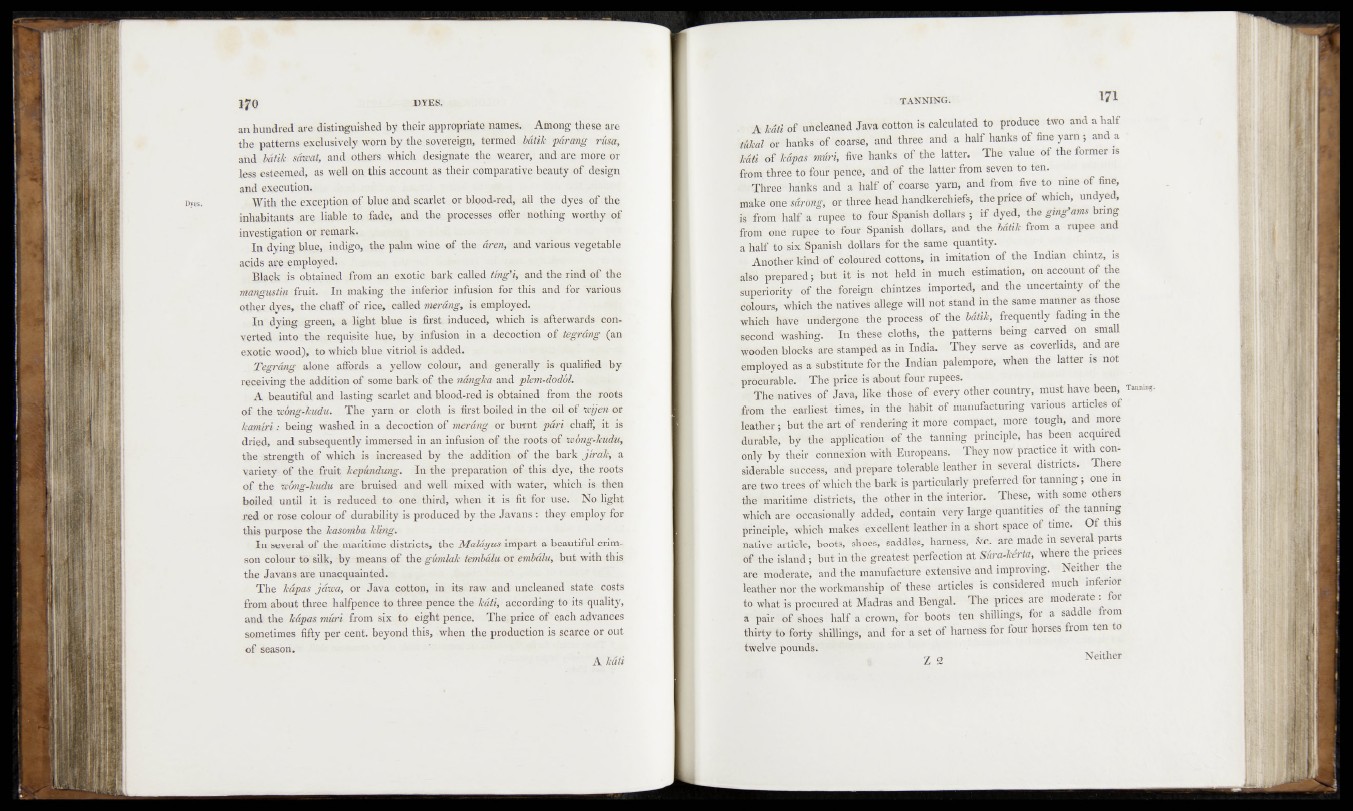
an hundred are distinguished by their appropriate names, Among these are
the patterns; exclusively worn by the sovereign, termed batik partmg r&sa,
add batik saviat, and others which designate the wearer, and are more or
less esteemed, as well on, this account as their comparative beauty of design
and execution!,
With the exception of blue and scarlet or blood-red, all the dyes of. the
inhabitants are liable to, fade, and the processes offer nothing worthy of
investigation opt remarls.
In dying blue, indigo, the palm wine of the arm, and various vegetable
acids are employed,
Slack is obtained from an exotic bark called ting’i, and tbe rind of the
raangnstin fruit. In making the inferior infusion for this and for various
other dyes, the chaff of rice, called meeting, is employed.
In dying green, a light blue is first, induced, which is afterwards converted
into the requisite hue, by infusion in a decoction of tegrang (an
exotic wood)-, to which blue vitriol is added.
Tegrang alone affords a yellow colour, and generatty. is qualified by
receiving the addition of some bark of the ndngka- and plem-d&dol ..
A beautiful and lasting scarlet and blood-red is qbtained from, the roots
of the wong-kudu. The yarn, or cloth is first boiled in the off of w0m ®r
kamiri: being washed in a decoction of merdng ■ or burnt pari 'chaff, -it is
dried, and subsequently immersed in an infusion of the roots of ’m6ng~kuduy
the strength of which is increased by the addition of the bark jirak, a
Variety of the. fruit kepundung. In the preparation of this dye, the roots
of the tpong-kudu are bruised and well mixed with water,, which iSr-then
boiled, until it is reduced to. one. third, when it is ‘ fit tfbr use. No. light
red or rose colour of durability is produced by the Javans: they .employ for
this purpose the kasomba kting.
In several of the, maritime districts, the MaMyus. impart a beautiful crimson
colour to sill;, by means, of the gumlaJe tembdlu or embdlu, but with this
the Javans are unacquainted.
The kapas jama, or Java , cotton, in its raw and uncleaned state- costs
from about three, halfpence to three pence, tbe kati; according to its quality,
and the kdpas muri from six to eight pence. The.price of' each advances
sometimes fifty per cent, beyond this, when the production is scarce or out
of season.
A kdti
A kdti of uiieleaned Java cotton is calculated to produce two and a half
m m or hanks of coarse, and three and a half hanks of fine yarn; and a
m of kapas mtirh five hanks of the latter. The value of the former is
from three to four pence, and of the latter from seven to ten.
.'Three hanks and a half of coarse yarn, and from five to nine of fine,
make one sêraftgi or three head handkerchiefs, the price of which, undyed,
is' from half a rupee to four Spanish dollars ; if dyed, the gmg’ams bring
from one rupeé to'four Spanish dollars, and the batik from a rupee and
a half to six Spanish dollars for the same quantity.
- Another kind of Coloured cottons, in imitation of the Indian chintz, is
also prepared; but it is not held in much estimation, on account of the
superiority of the foreign chintzes imported, and the uncertainty of the
colours, which tbe natives allege will not stand in the same manner as those
which have undergone the process of the batik, frequently fading in the
second washing.- In these cloths, the patterns being carved on small
Wooden blocks are stamped as in India. They serve as coverlids, and are
employed as a substitute for the Indian palempore, when the latter is not
procurable. The price is about four rupees- 1
Thematives of Java, like: those of evety other country, must have been,
from the earliest times, in the habit of manufacturing various articles of
leather; but the art of rendering it more compact, more tough, and more
durable, fry the application of the tanning principle, has been acquired
only Jty theii5 ■ connexion with Europeans. They now practice it with considerable
success,, and prepare tolerable leather in several districts. There
are two trees óf which the bark is particularly preferred for tanning; one m
the maritime districts, the other in the interior. These, with some others
Which ate occasionally added, contain vèry large quantities óf the tapmng
principle, which makes excellent leather in a short space óf time. Of this
native article, boots, shoes, saddles, harness, &c. are made m several parts
of the island; but in the greatest perfection at Séra-kérta, where the prices
are moderate, and the manufacture extensive and improving. Neither the
leather nor the workmanship of these articles is considered much inferior
to What is procured-at Madras and Bengal. The prices are moderate : for
a pair of shoes half a crown, for boots ten shillings, for a sadd e rom
thirty to forty shillings, and for a set of harness for four horses from ten to
twelve pounds.
Z 2 Neither